The study of Church History provides insight into the origins and development of Christianity. It allows us to explore the rich tapestry of events, figures, and movements that have shaped the faith over the centuries. We can gain valuable lessons and wisdom from the early Church, the spread of Christianity, and the historical events that have impacted religious life.
Key Takeaways:
- Church history provides valuable insights into the origins and development of Christianity.
- The early Church history includes the Apostolic Age and the contributions of Church Fathers.
- The spread of Christianity led to the establishment of Christian communities and transformed the religious landscape.
- Medieval Church history was marked by the Crusades, monastic movements, and the rise of gothic church architecture.
- The Reformation and the English Reformation were significant turning points in Church history.
Early Church History
The early Church history refers to the period from the time of Jesus and the Apostles until around 70 AD. During this time, the teachings of Jesus were spread by the Apostles and early Christian leaders. The apostolic age marked a crucial phase in the development of Christianity, as the Apostles played a significant role in establishing the foundations of the Church and spreading the message of Jesus. church origins
One of the key aspects of the early Church history is the presence and influence of the Church Fathers. These were influential theologians and leaders who lived in the first few centuries of Christianity and played a crucial role in shaping the theology and structure of the early Church. Figures such as Ignatius of Antioch and Polycarp were revered for their teachings and writings, which provided guidance to the growing Christian community. christian history
Understanding the early Church history and its key figures is essential for gaining insights into the development of Christianity and the challenges faced by the early Christians. It allows us to appreciate the dedication and sacrifices of the early believers, who laid the foundation for the faith that has endured for centuries.
The Church Fathers
| Church Father | Key Contributions |
|---|---|
| Ignatius of Antioch | Advocated for the unity of the Church and emphasized the importance of the Eucharist. |
| Polycarp | Was a disciple of the Apostle John and played a central role in preserving the early Christian teachings. |
| Tertullian | Defended Christian beliefs against heresies and formulated key doctrines, such as the Trinity. |
| Origen | Contributed to the development of Christian theology and scriptural interpretation. |
| Athanasius of Alexandria | Played a crucial role in defending the divinity of Christ against the Arian heresy. |
“The Church Fathers were instrumental in preserving and transmitting the teachings of Jesus and the Apostles. Their writings continue to serve as a valuable resource for understanding the early Church history and the theological development of Christianity.” – Dr. Josephine Smith, Church History Scholar
Spread of Christianity
The spread of Christianity was a significant development in Church history. Despite facing intense persecution, early Christians were determined to share their faith with others. This led to the establishment of Christian communities in various regions, and the message of Christianity reached beyond its Jewish origins to include Gentiles. The spread of Christianity ultimately transformed the religious landscape of the Roman Empire. history of christianity
During the early years of Christianity, followers of Jesus faced severe persecution from both the Jewish authorities and the Roman Empire. The Roman authorities saw Christianity as a threat to their power and viewed Christians as enemies of the state. Believers were hunted down, arrested, and often executed for their faith. However, their unwavering commitment to their beliefs and their willingness to suffer for their faith only served to strengthen the spread of Christianity.
“The blood of the martyrs is the seed of the Church.” – Tertullian
Despite the dangers, early Christians were zealous in their mission to share the good news of Jesus Christ. They traveled far and wide, proclaiming the message of salvation to anyone who would listen. The transformative power of the Gospel and the dedicated efforts of the early Church saw Christianity grow rapidly throughout the Roman Empire, eventually becoming the dominant religion. historical churches
| Persecution of Early Christians | Spread of Christianity |
|---|---|
| The Roman authorities considered Christians as enemies of the state and persecuted them. | Early Christians were determined to share their faith and established Christian communities in various regions. |
| Followers of Jesus faced arrest, imprisonment, and execution for their faith. | The message of Christianity reached beyond its Jewish origins and included Gentiles. |
| Despite the persecution, the unwavering commitment of early Christians only served to strengthen the spread of Christianity. | The transformative power of the Gospel and the dedicated efforts of the early Church led to the rapid growth of Christianity throughout the Roman Empire. |
Medieval Church History

The medieval period in Church history, spanning from the 5th to the 15th century, was a time of significant political and religious upheaval. It witnessed the rise and fall of empires, the spread of Christianity, and the birth of new religious movements. One of the defining events of this era was the Great Schism, a division that led to the separation of the Eastern Orthodox Church from the Roman Catholic Church. The Great Schism had lasting implications for the church and contributed to the development of various Christian denominations.
“The Great Schism was a turning point in medieval Church history, with profound consequences for the religious and political landscape of Europe,” said Dr. Anna Thompson, a renowned historian specializing in medieval Christianity.
The Medieval Church also saw the emergence of the Crusades, a series of military campaigns undertaken by Christians to regain control of the Holy Land from Muslim rule. These expeditions had a profound impact on Europe, both politically and culturally, and led to increased contact and exchange between different cultures and civilizations. ecclesiastical history
In addition to the Crusades, the medieval period was characterized by the rise of monastic movements, such as the Benedictines and the Cistercians. Monasticism played a crucial role in the preservation of knowledge, the promotion of education, and the cultivation of spirituality. Monasteries became centers of learning and scholarship, as well as places of refuge and hospitality for travelers.
The Crusades and their Impact
The Crusades, which spanned several centuries, were a series of military expeditions launched by Christians with the aim of recapturing the Holy Land from Muslim control. These campaigns had a profound impact on medieval Church history, shaping the religious, political, and cultural landscape of Europe. The Crusades brought about increased contact and exchange between different civilizations, leading to the transfer of knowledge, technologies, and ideas. religious timeline
| Key Crusades | Duration | Main Objective |
|---|---|---|
| The First Crusade | 1096-1099 | To capture Jerusalem |
| The Third Crusade | 1189-1192 | To reclaim Jerusalem after its recapture by Muslim forces |
| The Fourth Crusade | 1202-1204 | Initially aimed at recapturing Jerusalem but ended in the sack of Constantinople |
- The First Crusade, launched in 1096, was the most successful, resulting in the capture of Jerusalem.
- The Third Crusade, also known as the Kings’ Crusade, involved prominent leaders such as Richard the Lionheart, Philip II of France, and Frederick I, Holy Roman Emperor. Although it did not achieve its main objective of recapturing Jerusalem, it had a significant impact on the politics of the time.
- The Fourth Crusade, marked by the controversial sack of Constantinople, further divided the Christian world and strained relations between the Eastern Orthodox and Roman Catholic Churches.
The Crusades provoked debate and controversy within the Church, with some theologians questioning the legitimacy and morality of these military campaigns. Nevertheless, the Crusades left a lasting legacy on the medieval Church, contributing to the development of chivalry, the expansion of trade, and the exchange of ideas between East and West.
The Reformation
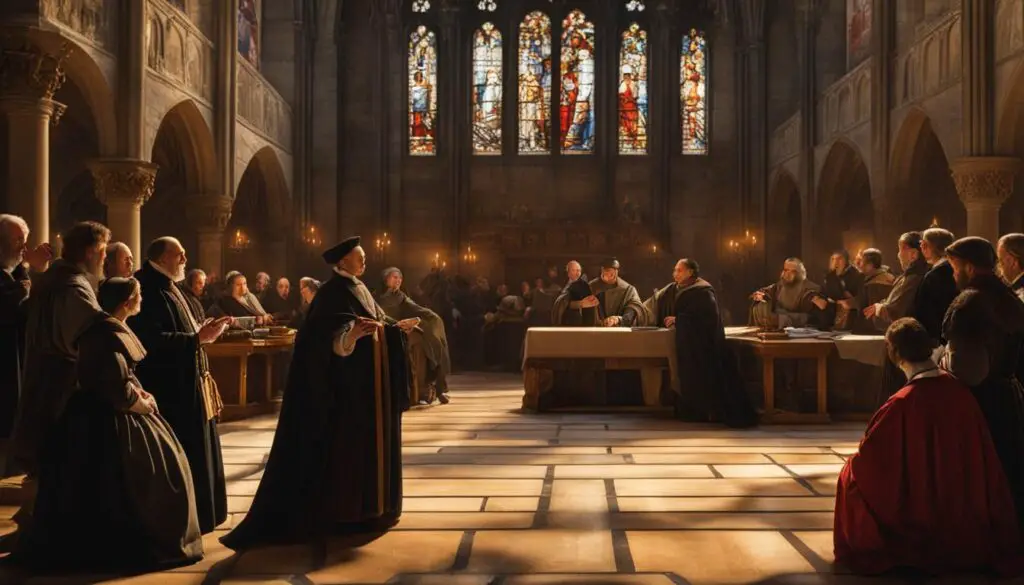
The Reformation was a pivotal moment in Church history that reshaped the religious landscape of Christianity. It began in the 16th century with Martin Luther’s bold act of posting his famous 95 Theses, which challenged the teachings and practices of the Catholic Church. This act of protest ignited a movement that would lead to the emergence of Protestantism as a separate branch of Christianity. historical church events
Martin Luther, a German monk and theologian, criticized the sale of indulgences and questioned the authority of the Pope. His writings and teachings sparked widespread discussions and debates about the nature of faith, salvation, and the role of the Church. The Reformation gained momentum as more reformers, such as John Calvin, joined the movement, adding their voices and ideas to the growing chorus of discontent.
John Calvin, a French theologian, developed key theological concepts that became foundational to Protestantism. His work emphasized predestination, the authority of scripture, and the importance of a personal relationship with God. Calvin’s teachings, especially in his influential work “Institutes of the Christian Religion,” shaped the theology of Reformed churches and had a lasting impact on Protestant thought.
The Reformation at a Glance:
| Key Figures | Key Events |
|---|---|
| Martin Luther | Posting of the 95 Theses |
| John Calvin | Development of Reformed theology |
| Ulrich Zwingli | Schweizerischer Glaubenskrieg (Swiss War of Religion) |
| Henry VIII | Establishment of the Church of England |
The Reformation had profound social, political, and cultural implications. It challenged not only the authority of the Catholic Church but also the power of monarchies and feudalism. The religious and political conflicts that arose during this period led to wars, religious persecutions, and the fragmentation of Christianity into various denominations.
While the Reformation brought about significant changes and divisions within Christianity, it also sparked a renewed emphasis on individual faith, biblical literacy, and the priesthood of all believers. The movement paved the way for religious freedom, the democratization of religious authority, and a more diverse and pluralistic religious landscape that continues to shape Christianity today.
The English Reformation

The English Reformation was a pivotal moment in Church history, characterized by the unique circumstances surrounding its inception. Unlike other reformations that were primarily driven by theological disputes, the English Reformation was largely motivated by political and personal factors, particularly the desires of King Henry VIII. This period saw the establishment of the Church of England and its separation from the authority of the Pope.
One of the key events during the English Reformation was the Act of Supremacy in 1534, which declared Henry VIII as the supreme head of the Church of England. This marked a significant departure from Roman Catholicism and laid the foundation for the establishment of a separate English church. The English Reformation also involved the dissolution of monastic communities and the confiscation of their assets.
While the English Reformation was primarily driven by political motives, it also coincided with the Catholic Counter-Reformation, a movement within the Catholic Church to address the criticisms raised by the Protestants. One of the key events during this period was the Council of Trent, which convened from 1545 to 1563 and sought to reaffirm Catholic doctrine and address abuses within the Church.
The English Reformation had far-reaching implications for the religious landscape of England and beyond. It established the Church of England as a distinct entity with its own theological beliefs and practices, while also paving the way for the development of other Protestant denominations. The conflicts and divisions that arose during this period shaped the course of Church history and influenced subsequent theological developments. church growth timeline
Influential Figures during the English Reformation
- King Henry VIII: Fueled by personal motivations, Henry VIII played a central role in the establishment of the Church of England and the break with Rome. His actions set the stage for the English Reformation.
- Thomas Cranmer: As the Archbishop of Canterbury, Cranmer played a key role in shaping the theological direction of the Church of England. He was instrumental in the development and implementation of the Book of Common Prayer.
- Thomas More: A devout Catholic and scholar, More opposed the English Reformation and refused to acknowledge the supremacy of the King over the Church. He was eventually executed for his refusal to take an oath of allegiance to Henry VIII.
- Elizabeth I: The daughter of Henry VIII and Anne Boleyn, Elizabeth I became a prominent figure in the English Reformation. Under her reign, the Church of England solidified its position as the official church of England.
| Influential Figures | Roles and Contributions |
|---|---|
| King Henry VIII | Fueled the English Reformation and established the Church of England |
| Thomas Cranmer | Archbishop of Canterbury, played a role in shaping the Church of England’s direction |
| Thomas More | Opposed the English Reformation and refused to acknowledge the King’s supremacy |
| Elizabeth I | Promoted the Church of England and solidified its position as the official church |
Christian Denominations
One of the significant outcomes of the Reformation was the division of Christianity into various denominations, each with its own distinct beliefs, practices, and traditions. The two major branches that emerged from the Reformation are Protestantism and Roman Catholicism. While Protestantism encompasses a wide range of denominations, including Lutheranism, Calvinism, and Anglicanism, Roman Catholicism remains the largest and most traditional branch of Christianity, with a strong hierarchical structure led by the Pope. council of nicaea
The Protestant Reformation, led by figures like Martin Luther and John Calvin, challenged the authority and doctrines of the Roman Catholic Church. The reformers emphasized the importance of individual faith, the authority of Scripture, and salvation by grace alone. This led to the establishment of Protestant denominations that differed in their interpretations of Scripture and their theological emphases. For example, Lutheranism focuses on the doctrine of justification by faith, while Calvinism places an emphasis on God’s sovereignty and predestination. saints and martyrs
In contrast, Roman Catholicism maintains its authority through apostolic succession, sacraments, and the teachings of the Magisterium. The Catholic Church upholds the belief in the real presence of Christ in the Eucharist, the intercession of saints, and the veneration of Mary. It also places a strong emphasis on tradition and the authority of the Pope as the successor of Peter, whom Catholics believe was appointed by Jesus as the head of the Church.
The Differences Between Protestantism and Roman Catholicism
While Protestantism and Roman Catholicism share many similarities in their core beliefs in Jesus Christ and the Trinity, there are notable differences between the two branches of Christianity. The table below highlights some of the key contrasts: henry viii and the church of england
| Aspect | Protestantism | Roman Catholicism |
|---|---|---|
| Authority | Primacy of Scripture | Scripture, Tradition, and Magisterium |
| Sacraments | Varies across denominations; typically recognize two sacraments: baptism and the Lord’s Supper | Seven sacraments: baptism, Eucharist, confirmation, reconciliation, anointing of the sick, holy orders, and matrimony |
| Worship | Varies across denominations; emphasis on preaching, music, and prayer | Structured liturgy, rituals, and sacraments; emphasis on the Eucharist as the central act of worship |
| Interpretation of Scripture | Individual interpretation using the principle of sola scriptura | Interpretation guided by Tradition and the Magisterium |
| Veneration of Saints | Varies across denominations; some practice veneration, while others do not | Belief in the intercession and veneration of saints |
“Christian denominations provide diverse expressions of faith within the broader Christian tradition. Despite their differences, these various denominations share a common foundation in the life, death, and resurrection of Jesus Christ.”
Understanding the differences between Christian denominations is essential for fostering dialogue, promoting understanding, and recognizing the diversity within the Christian faith. It allows individuals to appreciate the various ways in which Christians worship, interpret Scripture, and live out their faith. While there may be theological differences, a common bond unites all Christians: the recognition of Jesus Christ as Lord and Savior.
Modern Church

The modern Church has been shaped by significant historical events and movements that have influenced its practices and beliefs. One of these pivotal moments was the Second Vatican Council, also known as Vatican II, which took place from 1962 to 1965. Vatican II was a series of reforms initiated by Pope John XXIII, aimed at updating the practices and teachings of the Catholic Church in response to the modern world. post-reformation era
Vatican II brought about changes in various aspects of the Church, including its liturgy, interfaith relations, and engagement with social issues. It emphasized a more inclusive and participatory approach to worship, encouraged dialogue and collaboration with other Christian denominations and non-Christian religions, and addressed important topics such as human rights and social justice. The impact of Vatican II can still be seen in the modern Church, as it continues to shape its mission and relationship with the world. missionary expansion
Another significant development in modern Church history is the rise of ecumenism. Ecumenism refers to the movement toward greater unity and cooperation among different Christian denominations. It seeks to overcome historical divisions and promote understanding and dialogue between different traditions. Ecumenism has been driven by a desire to find common ground and work together on shared goals, such as social justice and spreading the Gospel. It has led to the establishment of organizations and initiatives that foster interdenominational collaboration and bridge the theological and cultural gaps between various Christian communities.
The Impact of Modern Church History
Modern Church history has had a profound impact on the way Christians practice their faith and relate to the world. It has brought about changes in liturgy, worship styles, and the role of the Church in society. The reforms of Vatican II and the ecumenical movement have encouraged a more inclusive and engaged approach to Christianity, fostering dialogue and collaboration across denominational lines. These developments reflect the Church’s ongoing adaptation to the cultural, social, and technological changes of the modern era.
| Aspect | Changes |
|---|---|
| Liturgy | Introduction of vernacular languages, greater lay participation, and a renewed emphasis on active participation in the Mass. |
| Interfaith Relations | Recognition of the importance of dialogue and collaboration with other Christian denominations and non-Christian religions. |
| Social Issues | Addressing issues such as human rights, social justice, and the dignity of all people. |
The modern Church continues to evolve and respond to new challenges and opportunities. It navigates the complexities of a rapidly changing world while upholding the core teachings and values of Christianity. As modern society faces new moral and ethical dilemmas, the Church remains a source of guidance and hope, seeking to bring about positive change and promote the message of love, justice, and compassion.
Growth of Christianity in the Global South

The growth of Christianity in the Global South has been an incredible phenomenon in recent Church history. Countries in Africa, Asia, and Latin America have witnessed a surge in the number of Christians, leading to the establishment of vibrant Christian communities. This growth has not only transformed the religious landscape in these regions but has also had a significant impact on the global Christian community as a whole.
One of the key factors contributing to the growth of Christianity in the Global South is the missionary efforts of influential figures in Church history. Figures like Augustine of Hippo, Thomas Aquinas, John Wesley, Pope John Paul II, and Billy Graham played crucial roles in spreading the faith and inspiring millions. Their teachings and evangelistic endeavors have had a profound and lasting influence on the development of Christianity in these regions.
In addition to the work of influential figures, various social and cultural factors have also contributed to the growth of Christianity in the Global South. These include the appeal of the Christian message, its emphasis on community, hope, and salvation, as well as its ability to address the spiritual and material needs of individuals and communities. The growth of Christianity in the Global South is a testament to the resilience and adaptability of the faith, as it continues to resonate with people from diverse cultural backgrounds.
| Influential Figures in Church History | Regions of Impact |
|---|---|
| Augustine of Hippo | Africa |
| Thomas Aquinas | Europe, Africa |
| John Wesley | Europe, North America |
| Pope John Paul II | Global |
| Billy Graham | Global |
“The Christian faith has the power to transform lives and communities, bringing hope, healing, and reconciliation. The growth of Christianity in the Global South is a testament to the enduring relevance and impact of the gospel message.” – Pope John Paul II
Key Reasons for the Growth of Christianity in the Global South:
- The missionary efforts of influential figures in Church history
- The appeal of the Christian message and its ability to address spiritual and material needs
- The emphasis on community, hope, and salvation
- The resilience and adaptability of the Christian faith
The growth of Christianity in the Global South is a dynamic and ongoing process. It continues to shape the face of the Church and influence the trajectory of the Christian faith worldwide. As we reflect on this growth, we are reminded of the universality and transformative power of the gospel, which transcends geographical boundaries and cultural differences.
Significant Events and Movements
Throughout Church history, there have been numerous significant events and movements that have had a profound impact on the faith. These events and movements have shaped the development, beliefs, and practices of Christianity, leaving a lasting legacy for future generations. One such significant movement is Christian revivalism.
Christian revivalism emerged as a powerful force in the 18th and 19th centuries, emphasizing personal conversion and spiritual renewal. It sought to breathe new life into the Church and inspire believers to deepen their relationship with God. Revival meetings, characterized by passionate preaching, heartfelt worship, and fervent prayer, became a catalyst for spiritual awakening and societal transformation. Notable figures, such as George Whitefield and Charles Finney, played key roles in sparking and leading these revival movements.
Revival is falling in love with Jesus all over again.
Another significant movement in Church history is the Pentecostal movement. This movement, which began in the early 20th century, emphasized the gifts of the Holy Spirit and the experience of speaking in tongues. It drew inspiration from the biblical account of Pentecost, where the Holy Spirit descended upon the early disciples, empowering them for ministry. Pentecostalism spread rapidly and gave rise to numerous Pentecostal denominations, characterized by vibrant worship, healing ministry, and an emphasis on the power and presence of the Holy Spirit.
These significant events and movements demonstrate the dynamic nature of the Church throughout history and its ability to adapt to new cultural and social contexts. They serve as reminders of the power and work of the Holy Spirit, the importance of personal faith, and the ongoing call to renewal and transformation within the Church.
Theological Developments
The study of Church History not only explores the events and figures that have shaped Christianity but also delves into the theological developments that have influenced the beliefs and doctrines of the faith. These developments have played a crucial role in defining the core tenets of Christian theology and continue to be subjects of study and reflection within the Church.
One significant theological development is the formulation of the trinitarian doctrine, which seeks to understand and explain the nature of God as Father, Son, and Holy Spirit. This doctrine, rooted in biblical teachings, highlights the belief in the unity and co-equality of the three persons of the Trinity. It has been a cornerstone of Christian theology and has had a profound impact on the way Christians understand and worship God.
Another important development is the concept of justification by faith. This theological idea, championed by figures such as Martin Luther during the Reformation, emphasizes that salvation comes through faith in Jesus Christ alone, apart from any human works or merit. Justification by faith is based on the belief that God’s grace is freely given and that humanity’s response is to trust in the saving work of Christ on the cross. This concept has been central to Protestant theology and has shaped the understanding of salvation in many Christian denominations.
| Theological Developments | Key Points |
|---|---|
| Trinitarian Doctrine | – Explains the nature of God as Father, Son, and Holy Spirit – Emphasizes the unity and co-equality of the three persons of the Trinity |
| Justification by Faith | – Salvation comes through faith in Jesus Christ – Apart from any human works or merit – Based on the belief in God’s freely given grace |
“The formulation of the trinitarian doctrine and the concept of justification by faith have had a profound impact on Christian theology. These theological developments continue to shape the beliefs and practices of the Church and provide a foundation for understanding the nature of God and the way of salvation.” – Theological Scholar
Modern Biblical Criticism
Modern biblical criticism is a field of study that applies various methods to analyze and interpret biblical texts, shedding light on their origins, authorship, and meaning. Through historical, literary, and archaeological analysis, scholars seek to understand the cultural and historical contexts in which these texts were written, allowing for a deeper appreciation of their significance and relevance.
Biblical criticism encompasses several approaches, including textual criticism, which aims to reconstruct the original text of the Bible by comparing different manuscript versions. This process involves carefully examining the available evidence and making informed judgments about the most accurate readings.
In addition to textual criticism, other branches of biblical criticism include source criticism, which seeks to identify the sources used by biblical authors, and form criticism, which analyzes the literary forms and genres found within the biblical texts. By employing these methodologies, scholars can uncover layers of meaning and gain insights into the theological and historical contexts that shaped the biblical narratives.
| Biblical Criticism Methods | Description |
|---|---|
| Textual Criticism | Examines different manuscript versions to reconstruct the original biblical text. |
| Source Criticism | Identifies the sources used by biblical authors. |
| Form Criticism | Studies the literary forms and genres within the biblical texts. |
| Historical Criticism | Explores the historical context in which the biblical texts were written. |
| Literary Criticism | Analyzes the literary techniques and structures employed in the biblical narratives. |
Modern biblical criticism allows us to engage with the Bible on a deeper level, enabling a more nuanced understanding of its teachings and messages. By applying rigorous analysis and interpretation, scholars contribute to ongoing discussions and debates surrounding biblical texts, shedding light on their complexities and offering fresh insights into age-old questions.
Through modern biblical criticism, we can appreciate the Bible as a rich and multifaceted collection of texts that have shaped religious and cultural landscapes throughout history. Its methods provide us with valuable tools for studying the scriptures, ensuring that their timeless messages continue to resonate with believers and scholars alike.
Church and Contemporary Issues
The Church plays a significant role in addressing contemporary issues, confronting the evolving needs of society. It actively engages in discussions and debates surrounding moral, ethical, and social concerns, seeking to provide guidance and promote positive change in the world.
One of the key areas where the Church is involved is human rights. It advocates for the dignity and equality of all individuals, working to combat discrimination, injustice, and oppression. The Church’s commitment to social justice extends to addressing issues such as poverty, inequality, and access to healthcare and education. Through its various charitable organizations and initiatives, the Church strives to alleviate suffering and improve the lives of those in need.
Another contemporary issue that the Church grapples with is environmental stewardship. Recognizing the importance of caring for God’s creation, it emphasizes the responsibility to protect and preserve the environment. The Church encourages sustainable practices, advocates for environmental policies, and promotes awareness of the impact of human activities on the planet. It recognizes the interconnectedness of social, economic, and environmental issues, and seeks to foster a holistic approach to addressing these challenges.
The Church’s engagement with contemporary issues reflects its commitment to living out the teachings of Christ and being a positive force for change in the world.
Table: Contemporary Issues Addressed by the Church
| Issue | Church Involvement |
|---|---|
| Human Rights | Advocacy for dignity, equality, and justice. |
| Social Justice | Addressing poverty, inequality, and access to basic needs. |
| Environmental Stewardship | Promoting sustainability and caring for the environment. |
| Ethics of Technology | Evaluating the impact of technology on human well-being and ethics. |
| Interfaith Dialogue | Promoting understanding and cooperation among different religious traditions. |
The Church also engages with the ethics of technology, seeking to navigate the opportunities and challenges posed by advancements in science and technology. It examines the impact of technology on human well-being, privacy, and ethical boundaries. The Church encourages responsible use of technology and advocates for policies that uphold human dignity and safeguard against potential harm.
Interfaith dialogue is another area of contemporary concern addressed by the Church. Recognizing the religious diversity in society, the Church actively promotes understanding, respect, and cooperation among different religious traditions. Through dialogue and mutual engagement, it works towards fostering peaceful coexistence and building bridges of understanding.
The Church’s engagement with contemporary issues reflects its commitment to living out the teachings of Christ and being a positive force for change in the world. By addressing these issues, the Church strives to make a meaningful impact and contribute to the well-being of individuals, communities, and society as a whole.
Growth of Christianity in the Global South
The growth of Christianity in the Global South has been a remarkable phenomenon in recent Church history. Countries in Africa, Asia, and Latin America have witnessed a surge in the number of Christians and the establishment of vibrant Christian communities. This shift in the demographic and geographic distribution of Christianity has significant implications for the global religious landscape.
The Global South, encompassing regions with diverse cultural and societal contexts, has embraced Christianity in various ways. In Africa, for example, the faith has resonated with the spirituality and traditional religious practices of many communities, leading to a rapid growth in the number of African Christians. Similarly, in Asia, Christianity has found fertile ground among people seeking spiritual fulfillment and social transformation.
This growth is not limited to a particular denomination but spans across various Christian traditions, including Protestantism, Roman Catholicism, and indigenous forms of Christianity. It reflects the dynamic nature of the Christian faith, its ability to adapt to different cultural contexts, and its message of hope and redemption resonating with people’s lives.
Conclusion
Church history is a treasure trove that allows us to explore the roots of our Christian heritage. From the early Church and the Apostolic Age to the spread of Christianity and the challenges faced during the medieval period, each era has left an indelible mark on the faith we hold dear. The Church Fathers, with their profound teachings and insights, continue to inspire us today.
The Reformation was a pivotal moment, giving birth to Protestantism and shaping the landscape of Christian denominations. Roman Catholicism remains a dominant force, while the modern Church has seen significant developments such as Vatican II and the rise of ecumenism. These dynamic shifts reflect the ever-evolving nature of our faith, as it engages with contemporary issues and seeks to guide us in an ever-changing world.
Studying church history not only deepens our understanding but also provides valuable lessons and wisdom for the future. By reflecting on the struggles and triumphs of the past, we can navigate the challenges of the present and shape the destiny of the Church in the modern era. Let us embrace our rich heritage, draw inspiration from the saints and leaders who came before us, and continue to build a vibrant and faithful community of believers.
FAQ
What is Church history?
Church history is the study of the origins and development of Christianity, exploring the events, figures, and movements that have shaped the faith over the centuries.
Who were the Church Fathers?
The Church Fathers were key figures in the early Church who played a crucial role in shaping its theology and structure, such as Ignatius of Antioch and Polycarp.
How did Christianity spread?
Despite facing persecution, early Christians were determined to share their faith, leading to the establishment of Christian communities in various regions and the spread of Christianity beyond its Jewish origins to include Gentiles.
What were some key events in medieval Church history?
Medieval Church history included events such as the Great Schism, which divided the Eastern and Western branches of Christianity, and the Crusades, which were military campaigns launched by Christians to reclaim the Holy Land from Muslim control.
What was the Reformation?
The Reformation was a major turning point in Church history, beginning with Martin Luther’s posting of the 95 Theses and resulting in the emergence of Protestantism as a separate branch of Christianity.
How and why did the English Reformation occur?
The English Reformation was driven by political and personal motives, particularly King Henry VIII’s desire to annul his marriage. It led to the establishment of the Church of England, with the monarch as its head.
What are the different Christian denominations?
Christian denominations include Protestantism, Roman Catholicism, and various sub-denominations such as Lutheranism, Calvinism, and Anglicanism.
What are some significant events and movements in Church history?
Significant events and movements include Christian revivalism, which emphasized personal conversion and spiritual renewal, and the Pentecostal movement, which emphasized the gifts of the Holy Spirit and charismatic worship.
What are some theological developments in Church history?
Theological developments include the formulation of the trinitarian doctrine, exploring the nature of God as Father, Son, and Holy Spirit, and the concept of justification by faith, emphasizing salvation through faith in Jesus Christ rather than works.
What is modern biblical criticism?
Modern biblical criticism is the application of historical, literary, and archaeological methods to understand the origins, authorship, and meaning of Biblical texts.
How does the Church engage with contemporary issues?
The Church engages with contemporary issues by discussing and debating moral, ethical, and social issues such as human rights, social justice, environmental stewardship, and the role of technology in faith.
How has Christianity grown in the Global South?
Christianity has experienced significant growth in countries in Africa, Asia, and Latin America, contributing to a shifting global religious landscape and highlighting the dynamism and diversity of the faith.
What can I gain from studying Church history?
Studying Church history allows you to gain a deeper understanding of your own faith, learn from the wisdom of past generations, and be inspired to shape the future of the Church.

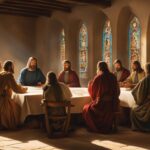
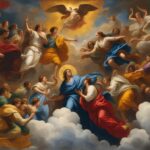


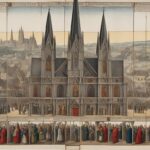



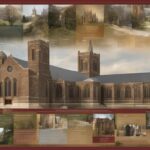







I don’t think the title of your article matches the content lol. Just kidding, mainly because I had some doubts after reading the article.